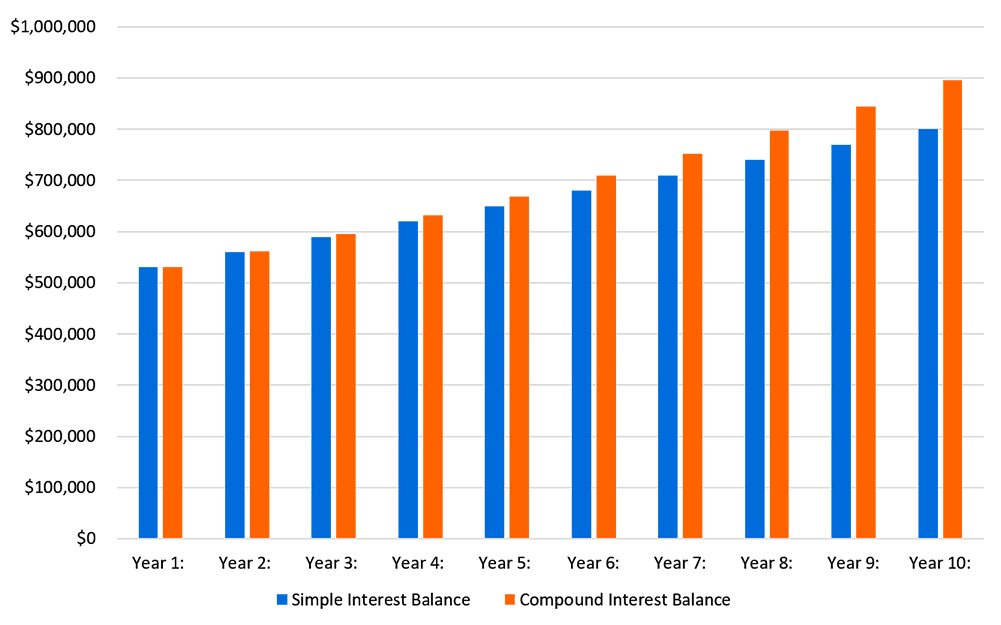Is Compound Interest the Most Powerful Force
in the Investment Universe?
 Recently, I was discussing compound interest and the best time to start investing with a major league baseball player in his mid-20s who was in the office. He had the insight to understand that he will not be able to play baseball for the rest of his life and was seeking advice about whether he should begin investing for retirement.
Recently, I was discussing compound interest and the best time to start investing with a major league baseball player in his mid-20s who was in the office. He had the insight to understand that he will not be able to play baseball for the rest of his life and was seeking advice about whether he should begin investing for retirement.
Because of the benefit of compound interest, which could be for 40 or more years in his case, I recommended he immediately begin making investments for retirement. Before we explore why compound interest is so important, can you envision a day when all millennials are as responsible about their future finances as this young athlete? Imagine That™!
What Does “Compound Interest” Really Mean?
The technical definition of “compound interest” or “compounding interest“ is interest calculated on the initial principal of a deposit (or loan) and also on the accumulated interest of previous periods. Translated: compound interest is “interest on interest.” Compound interest will make your money grow much faster than if you received interest only on the principal amount, which is called “simple interest.”
Here is a graph which compares simple and compound interest and shows why getting “interest on interest” is so – well – interesting! The initial investment is $500,000 for both accounts with an annual interest rate of 6%.
Simple vs. Compound Interest Chart

The above graph indicates that the simple interest investment earns an additional $30,000 each year ($500,000 x .06) and by year 10, the initial investment of $500,000 has grown to $800,000. The compound interest balance was the same as the simple interest balance in year one, but because it then earned “interest on interest,” it beat the simple interest balance in the remaining years. By year 10, the compound interest balance was more than $95,000 higher than the simple interest rate balance.
An urban legend is that Dr. Albert Einstein once said
“Compound interest is the most powerful force in the universe. He [or she] who understands it, earns it . . . He [or she] who doesn’t . . . pays it.”
Although Einstein likely did not make this assertion, the sentiment remains true — compound interest is truly an amazing way to increase your savings/investments over time.
Why Starting to Invest in Your 20s is one of the Best Things you can Do?
The following example illustrates why beginning to invest in your 20s is so beneficial. Sally invests $5,000 annually from age 25 to 35. In total, she invests $50,000 ($5,000 x 10). Bill, on the other hand, has a 10-year delay in beginning his investing but makes up for the delay by investing until he retires. Bill invests $5,000 annually from age 35 to 65. In total, Bill invests $150,000 ($5,000 x 30).
Assuming an annual return of 7% for Sally and Bill, who comes out with more money at age 65? Would you believe Sally? Even though Sally only invested for 10 years (versus 30 years for Bill), Sally will have significantly more money saved at age 65. At age 65, Sally will have $1.1 million versus Bill’s $602,000, even though Bill invested $100,000 more than Sally did! The only reason for the difference was that Sally invested earlier than Bill did and compound interest worked its wonders on the $50,000 that Sally initially invested.
The Importance of Long-Term Investment Goals: Start Investing Now
If you are not in your 20s, investing is even more important for your long-term goals. Unfortunately, many people do not understand the importance of long-term investment goals and the urge to start investing now, not next year. They think that by putting off the investment for another year, they are only losing out on that year’s contribution. They fail to recognize that they also lose a year of compounding interest.
Losing a year of interest on your retirement investments may not sound important but it can amount to an even greater loss than the initial contribution itself. Because of the extraordinary benefit of compound interest, waiting one year may make a difference of tens of thousands of dollars in accumulation in certain cases … just waiting a single year!
If your goal is to have $1 million saved by age 65, assuming a 6% annual return, here are the monthly amounts you need to begin investing:
Age: Monthly Investment Amount
20 $361.04
25 $499.64
30 $698.41
35 $990.55
40 $1,435.83
45 $2,153.54
50 $3,421.46
55 $6,071.69
60 $14,261.49
As the table above indicates, the longer you put off investing, the more you will have to invest each month to “catch up.” The largest increase in monthly investment amount occurs between ages 55 and 60; you will need to invest an extra $8,200 each month at age 60, as compared to age 55, because the compound interest effect will have a very small window of, at maximum, only 5 years to operate.
Conclusion: When is the Best Time to Start Investing?
So, when is the best time to start investing? Right now! And, the amount you begin setting aside is not as important as beginning the habit of routinely investing something. It develops a “positive addiction” – that is, you get “hooked” on something that is good for you! Start putting money away now! Create that positive addiction towards accumulating money for “future delivery.”
Can you imagine if everyone began investing money in their twenties to get the most benefit from the effect of compounding interest? Instead of the stress that so many Americans feel about retirement, they would have to find something else to worry about!
Imagine That™!
Imagine That™! is a complimentary monthly newsletter provided by Wealth Legacy Group®, Inc. that addresses various topics of interest for high-net-worth and high-income business owners, professionals, executives and their families. To be added to our monthly list, please click here.
Written by R. J. Kelly – January 2018
Read Next:
Volatility: The “New Normal” Why Traditional Investment Strategies No Longer Work Well
Why Are A Roth IRA And “Super-Roth” So Darn Attractive?
Will You Outlive Your Retirement Income?
12 Pitfalls & Traps That Will Keep You From Retiring Well
Photo credit: Coins nattanan23 CC0 1.0 Pixabay License

